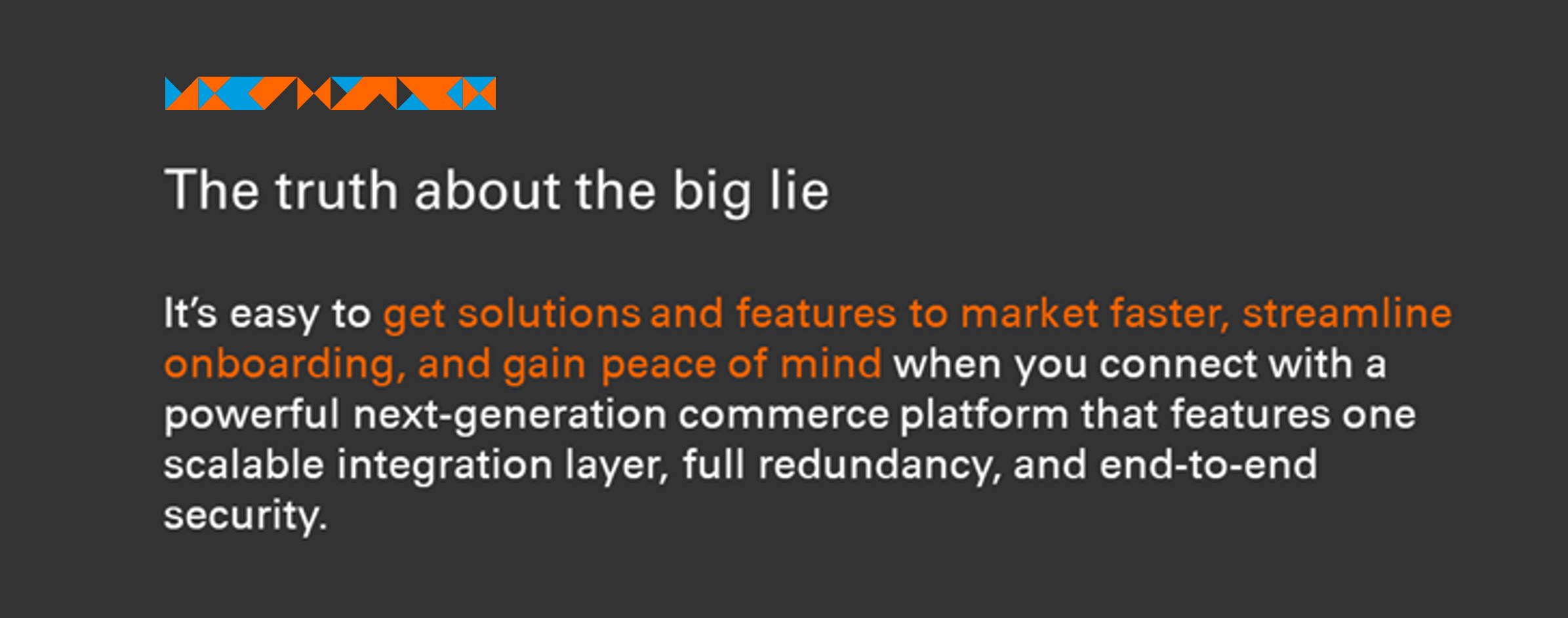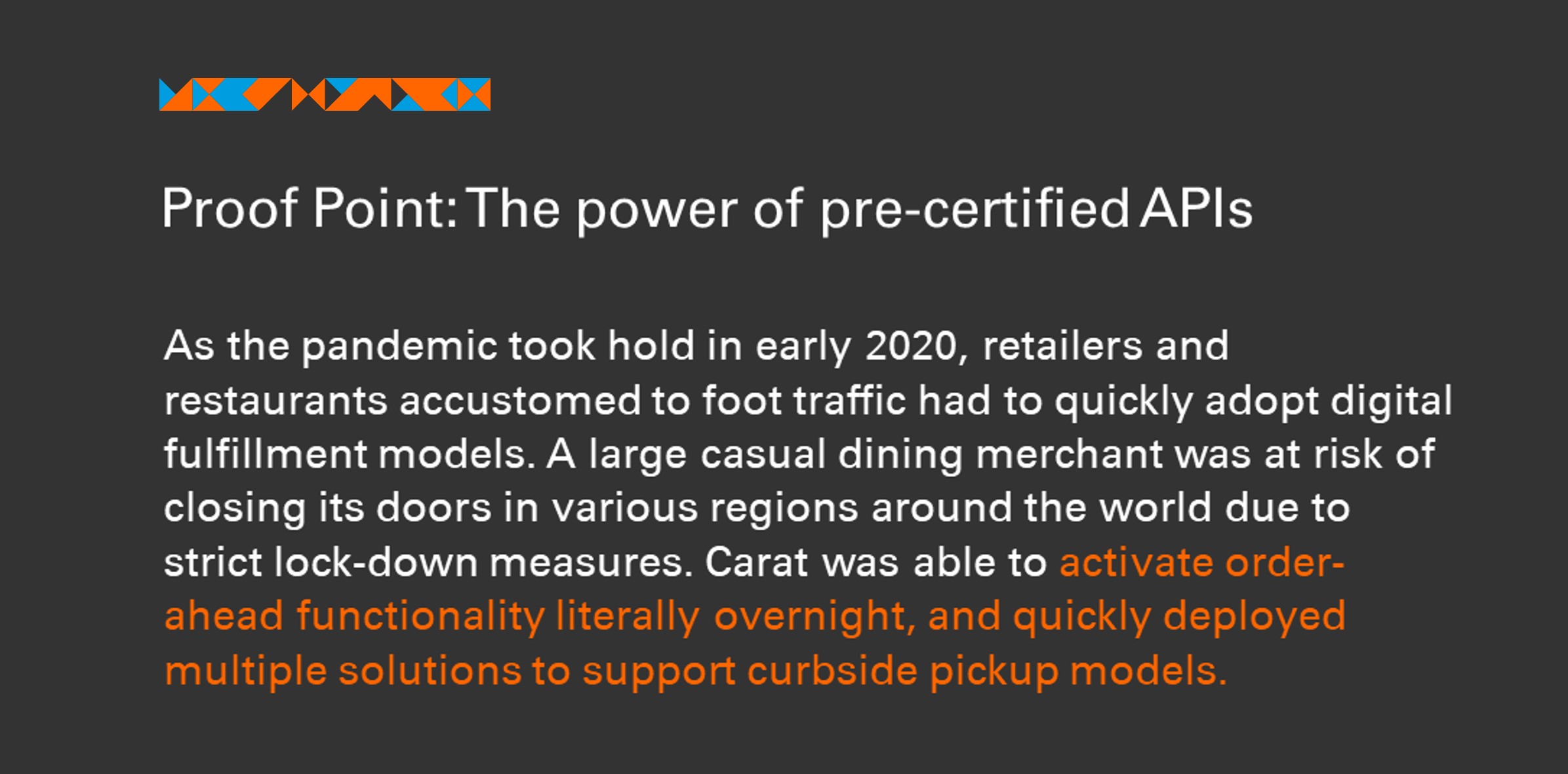
Commerce has become complicated for merchants. The lines between digital and physical channels have blurred, there has been a barrage of new payment methods and experiences in recent years, and it is increasingly necessary for enterprise businesses to connect to an ever-growing ecosystem of processors, platforms, and marketplaces. Trying to keep up with these trends—and stay ahead of nimble, new-age competitors—puts tremendous pressure on IT departments, forcing them to juggle priorities and resources while finding funds to deliver on promises. Navigating multiple vendors, contracts, specifications, certifications, data security, onboarding, and compliance overhead can be cumbersome and costly. But, we are going to let you in on a little secret:
- TRUE: Consumers demand a seamless experience across all channels.
- TRUE: IT departments are constantly wrangling for budgets and resources.
- TRUE: Legacy systems and processes are inefficient and difficult to scale.
- TRUE: Fraudsters keep getting smarter.
- FALSE: Easily reducing the costs and complexities of connected commerce is unattainable.
This article will reveal how the right solutions and infrastructure help IT teams simplify omnichannel integrations and scale for the future of commerce.

A single API can make universal commerce attainable
Channel technology silos for card present and card-not-present payment acceptance limit interactions between physical and digital worlds, resulting in clunky customer experiences. IT teams must connect to multiple processors and platforms via dozens of APIs, which leads to a disparate tech stack, additional cost overhead, and the cumbersome deployment of system enhancements and upgrades.
Simplify your integration with one set of true omnichannel APIs. Calling one API for authorization—that includes value-add services like omnichannel tokenization, 3D Secure, optimized routing, digital wallets, fraud prevention tools, and more—exponentially accelerates time to market. As new features come to market, they are immediately available for rapid integration.
Eliminate continuous development, certification, and release cycles with pre-certified connectivity to an array of acquirers, devices and back-office systems. A powerful rules engine can facilitate dynamic routing based on criteria including channel, card type, issuer, region and more, giving merchants more control of the experience.
Accelerate speed to market by using automated spec translations to eliminate the need for developers to code to new API specifications when moving onto a modern technology commerce platform. Existing API specs can be robotically consumed by a translator API, reducing the time and friction of converting to a new tech stack.
Streamline development and onboarding with self-service tools
Most developers are self-starters who want an easy way to access documentation, understand the API, and view sample payloads so they can quickly integrate features and functions without back-and-forth emails and conversations with vendor representatives.
When it comes to onboarding—terminals, employees, front-end, back-end, value-add services—most legacy systems still use outdated, cumbersome processes such as emails, spreadsheets, and forms. Plus, each vendor has its own systems and protocols, which multiplies the complexities across channels, locations, brands, and franchisees. It’s easy to imagine how converting stores from the result of a merger could quickly become a nightmare for administrators. Finally, documents, forms and emails aren’t just inefficient, they often don’t have adequate audit controls, which introduces the potential for fraud.
Offer developers more choice with built-in self-service tools that allow developers to choose their self-service journey based on their skill level and knowledge of payments. They can go from obtaining credentials to auto testing, certification, and production in as little as an hour depending on channel, payment types and rules. And if time isn’t a driving factor, a junior programmer could be assigned to integrate new features, supported by informative documentation and tutorials, allowing more experienced programmers to focus on high-priority projects.
Simplify onboarding with intuitive wizard-based interfaces in a self-service portal allowing administrators to follow logical steps in the onboarding journey. This gives them a huge lift when bringing on new locations and setting up features, routing rules, and other modifiers. Optionally, a merchant can integrate to an onboarding API, which gives them the ability to stay within their own systems and screens to define the payment services and features needed across their enterprise’s footprint.
Maximize stability and performance with next-generation infrastructure
Commerce is all about moving money. A single network outage could mean millions in losses for businesses and damaged brand perception, especially in eCommerce channels where the competition is one click away. In-store and digital systems demand maximum uptime so businesses can capitalize on every sale. Customers can’t wait for a systems administrator to respond to an alarm, log in and remedy a problem.
Redundancy, scale and automated detection and recovery are key requirements for infrastructure, be it hardware, software, or services. The highest security standards must be maintained from the moment a payment is initiated.
Help protect yourself against human error and disasters with full systems redundancy and fast transaction speeds crucial for processing payments. A cloud environment—one which requires zero human intervention—provides for automated back-up for every type of maintenance or disaster scenario. It also allows new hardware or services to come online without interruption.
Quickly scale, in response to network and customer needs, across your entire payment technology stack, from infrastructure to applications. Whether needed as a back-up plan, or to quickly bring up new functionality in response to market forces and trends, consistently exposing APIs and services across regions drives real value.
Remove the need for human intervention with instant responses to influxes in volume, planned or unexpected, across your global footprint with auto scaling. This extends peace of mind, especially during peak sales seasons and events.
Detect and correct problems with constant monitoring and automated self-healing in real-time. Non-performing systems or third-party network connections can be taken out of production and traffic can seamlessly be redirected to another instance of the servers that can handle the load.
Help protect data with end-to-end security, from initiation all the way through gateways and back-end systems. Unencrypted data never enters the payment stream, and tokens protect data at rest.

Learn more about how you can simplify your omnichannel integration or contact a Carat expert today.




